The First Thirty Years of Green Stormwater Infrastructure in Portland, Oregon
Abstract
1. Introduction
2. Methods
2.1. Site Description
2.2. Data Collection
3. Results
3.1. Historical Evolution of GSI in Portland
3.1.1. Initial Drainage Design (1845–1990)
3.1.2. Early Innovations and Pilot Projects (1990–1999)
3.1.3. Expansion and Formalization (2000–2005)
3.1.4. Reducing Combined Sewer Overflows (2006–2011)
3.1.5. Mainstreaming and Maturation (2012–2020)
3.1.6. Policy Evolution and Equity Focus (2021–2025)
3.2. Innovative Case Studies
3.2.1. Slough 104B Green Streets
3.2.2. Capitol Highway Bioretention
3.2.3. Washington Park Entry Planter
3.2.4. Northwest Housing Alternatives Combination Treatment and Detention Planter
4. Discussion
4.1. Impact Assessment
4.1.1. Hydrologic Improvements
4.1.2. Water Quality Improvements
4.1.3. Social Impacts
4.2. Lessons Learned and Challenges
4.2.1. Institutional Coordination
4.2.2. Community Engagement
4.2.3. Performance Monitoring and Maintenance
4.2.4. Water Quality Treatment
4.2.5. Climate Change
5. Conclusions
Author Contributions
Funding
Institutional Review Board Statement
Informed Consent Statement
Data Availability Statement
Acknowledgments
Conflicts of Interest
Abbreviations
| BES | City of Portland Bureau of Environmental Services |
| BPS | City of Portland Bureau of Planning and Sustainability |
| CSOs | Combined sewer overflows |
| DEQ | Oregon Department of Environmental Quality |
| EPA | US Environmental Protection Agency |
| FAR | Floor area ratio |
| GSI | Green stormwater infrastructure |
| MS4 | Municipal Separate Storm Sewer System |
| NHA | Northwest Housing Alternatives |
| NPDES | Portland’s National Pollutant Discharge Elimination System |
| OMSI | Oregon Museum of Science and Industry |
| O&M | Operations and maintenance |
| PBOT | City of Portland Bureau of Transportation |
| SEA | Seattle’s Street Edge Alternative |
| SWMM | Portland’s Stormwater Management Manual |
References
- Ferreira, C.S.; Walsh, R.P.; Ferreira, A.J. Degradation in urban areas. Curr. Opin. Environ. Sci. Health 2018, 5, 19–25. [Google Scholar] [CrossRef]
- Walsh, C.J.; Fletcher, T.D.; Burns, M.J. Urban Stormwater Runoff: A New Class of Environmental Flow Problem. PLoS ONE 2012, 7, e45814. [Google Scholar] [CrossRef]
- Brabec, E.; Schulte, S.; Richards, P.L. Impervious surfaces and water quality: A review of current literature and its implications for watershed planning. J. Plan. Lit. 2002, 16, 499–514. [Google Scholar] [CrossRef]
- Kessler, R. Stormwater strategies: Cities prepare aging infrastructure for climate change. Environ. Health Perspect. 2012, 119, a514–a519. [Google Scholar] [CrossRef]
- Tavakol-Davani, H.; Goharian, E.; Hansen, C.H.; Tavakol-Davani, H.; Apul, D.; Burian, S.J. How does climate change affect combined sewer overflow in a system benefiting from rainwater harvesting systems? Sustain. Cities Soc. 2016, 27, 430–438. [Google Scholar] [CrossRef]
- Moore, T.L.; Gulliver, J.S.; Stack, L.; Simpson, M.H. Stormwater management and climate change: Vulnerability and capacity for adaptation in urban and suburban contexts. Clim. Change 2016, 138, 491–504. [Google Scholar] [CrossRef]
- Kumar, S.; Agarwal, A.; Ganapathy, A.; Villuri, V.G.K.; Pasupuleti, S.; Kumar, D.; Kaushal, D.; Gosain, A.; Sivakumar, B. Impact of climate change on stormwater drainage in urban areas. Stoch. Environ. Res. Risk Assess. 2022, 36, 77–96. [Google Scholar] [CrossRef]
- Blair, A.; Lovelace, S.; Sanger, D.; Holland, A.F.; Vandiver, L.; White, S. Exploring impacts of development and climate change on stormwater runoff. Hydrol. Process. 2014, 28, 2844–2854. [Google Scholar] [CrossRef]
- EPA (Environmental Protection Agency). About Green Infrastructure. 2025. Available online: https://www.epa.gov/green-infrastructure/about-green-infrastructure (accessed on 7 May 2025).
- Trowsdale, S.; Simcock, R. Urban stormwater treatment using bioretention. J. Hydrol. 2011, 397, 167–174. [Google Scholar] [CrossRef]
- Zhang, W.; Brown, G.O.; Storm, D.E.; Zhang, H. Fly-ash-amended sand as filter media in bioretention cells to improve phosphorus removal. Water Environ. Res. 2008, 80, 507. [Google Scholar] [CrossRef]
- Davis, A.P.; Hunt, W.F.; Traver, R.G.; Clar, M. Bioretention technology: Overview of current practice and future needs. J. Environ. Eng. 2009, 135, 109. [Google Scholar] [CrossRef]
- Kim, H.; Seagren, E.A.; Davis, A.P. Engineered bioretention for removal of nitrate from stormwater runoff. Water Environ. Res. 2003, 75, 355. [Google Scholar] [CrossRef]
- Stutz, B. Green Roofs Are Starting to Sprout in American Cities; Yale Environment 360, Yale School of Forestry and Environmental Studies: New Haven, CT, USA, 2010. [Google Scholar]
- Dvorak, B.; Volder, A. Green Roof Vegetation for North American Ecoregions: A Literature Review. Landsc. Urban Plan. 2010, 96, 197–213. [Google Scholar] [CrossRef]
- Carpenter, C.; Todorov, D.; Driscoll, C.T.; Montesdeoca, M. Water quantity and quality response of a green roof to storm events: Experimental and monitoring observations. Environ. Pollut. 2016, 218, 664–672. [Google Scholar] [CrossRef]
- Harper, G.E.; Limmer, M.A.; Showalter, W.E.; Burken, J.G. Nine-month evaluation of runoff water quality and quantity from an experiential green roof in Missouri, USA. Ecol. Eng. 2015, 78, 127–133. [Google Scholar] [CrossRef]
- Clary, J.; Jones, J.; Leisenring, M.; Hobson, P.; Strecker, E. International Stormwater BMP Database: 2020 Summary Statistics; Water Research Foundation: Alexandria, VA, USA, 2020. [Google Scholar]
- Birch, G.F.; Fezeli, M.S.; Matthai, C. Efficiency of an infiltration basin in removing contaminants from urban stormwater. Environ. Monit. Assess. 2005, 101, 23–38. [Google Scholar] [PubMed]
- Winston, R.J.; Luell, S.K.; Hunt, W.F. Retrofitting with bioretention and a bioswale to treat bridge deck stormwater runoff. In Green Streets and Highways 2010: An Interactive Conference on the State of the Art and How to Achieve Sustainable Outcomes; American Society of Civil Engineers: Denver, CO, USA, 2010; pp. 147–162. [Google Scholar]
- Shafique, M.; Kim, R. Green stormwater infrastructure with low impact development concept: A review of current research. Desal. Water Treat. 2017, 83, 16–29. [Google Scholar] [CrossRef]
- Kwak, N.; Smith, V.; Good, K.D. Assessing the influence of green stormwater infrastructure implemented for combined sewer overflow control on urban streamflows. J. Hydrol. 2024, 640, 131670. [Google Scholar] [CrossRef]
- Le Cauchois, P.; Doucet, S.; Bouattour, O.; McQuaid, N.; Beral, H.; Kõiv-Vainik, M.; Bichai, F.; McCarthy, D.; St-Laurent, J.; Dagenais, D.; et al. Full-scale characterization of the effects of a bioretention system on water quality and quantity following the replacement of a mixed stormwater and combined sewer system. Blue-Green Sys. 2025, 7, 43–62. [Google Scholar] [CrossRef]
- Godyń, I.; Grela, A.; Muszyński, K.; Pamuła, J. The Impact of Green Infrastructure on the Quality of Stormwater and Environmental Risk. Sustainability 2024, 16, 8530. [Google Scholar] [CrossRef]
- Rosenzweig, B.; McPhillips, L.; Chang, H.; Cheng, C.; Welty, C.; Matsler, M.; Iwaniec, D. Urban pluvian flood risk and opportunities for resilience. Wires Water 2018, 5, e1032. [Google Scholar] [CrossRef]
- Chang, H.; Pallathadka, A. A case for change: Flood risk management and green infrastructure. Cell Rep. Sustain. 2025, 2, 100369. [Google Scholar] [CrossRef]
- Steis Thorsby, J.; Miller, C.J.; Treemore-Spears, L. The role of green stormwater infrastructure in flood mitigation (Detroit, MI USA)—Case study. Urban Water J. 2020, 17, 838–846. [Google Scholar] [CrossRef]
- Green, D.; O’Donnell, E.; Johnson, M.; Slater, L.; Thorne, C.; Zheng, S.; Stirling, R.; Chan, F.K.S.; Li, L.; Boothroyd, R.J. Green infrastructure: The future of urban flood risk management? Wiley Interdisc. Rev. Water 2021, 8, e1560. [Google Scholar] [CrossRef]
- Liu, W.; Chen, W.; Peng, C. Assessing the effectiveness of green infrastructures on urban flooding reduction: A community scale study. Ecol. Model. 2014, 291, 6–14. [Google Scholar] [CrossRef]
- Arabi, M.; Dell, T.; Zadeh, M.M.; Pomeroy, C.A.; Egan, J.M.; Wible, T.; Sharvelle, S. Community-enabled life-cycle assessment Stormwater Infrastructure Costs (CLASIC) tool. Environ. Model. Softw. 2025, 185, 106279. [Google Scholar] [CrossRef]
- Flynn, K.M.; Traver, R.G. Green infrastructure life cycle assessment: A bio-infiltration case study. Ecol. Eng. 2013, 55, 9–22. [Google Scholar] [CrossRef]
- Laub, B.G.; Von Bon, E., Jr.; May, L.; Garcia, M. The Hydrologic Mitigation Effectiveness of Bioretention Basins in an Urban Area Prone to Flash Flooding. Water 2024, 16, 2597. [Google Scholar] [CrossRef]
- Suppakittpaisarn, P.; Jiang, X.; Sullivan, W.C. Green infrastructure, green stormwater infrastructure, and human health: A review. Curr. Land. Ecol. Rep. 2017, 2, 96–110. [Google Scholar] [CrossRef]
- Ando, A.; Netusil, N. Valuing the Benefits of Green Stormwater Infrastructure. Oxf. Res. Encycl. Environ. Sci. 2018. Available online: https://oxfordre.com/environmentalscience/view/10.1093/acrefore/9780199389414.001.0001/acrefore-9780199389414-e-605 (accessed on 20 May 2025).
- Brent, D.A.; Gangadharan, L.; Lassiter, A.; Leroux, A.; Raschky, P.A. Valuing environmental services provided by local stormwater management. Water Resour. Res. 2017, 53, 4907–4921. [Google Scholar] [CrossRef]
- Gonzalez-Meler, M.A.; Cotner, L.A.; Massey, D.A.; Zellner, M.L.; Minor, E.S. The Environmental and Ecological Benefits of Green Infrastructure for Stormwater Runoff in Urban Areas. JSM Environ. Sci. Ecol 2013, 1, 1007. [Google Scholar]
- Garrison, N.; Hobbs, K. Rooftops to Rivers II; Natural Resources Defense Council: New York, NY, USA, 2011; Available online: https://www.nrdc.org/sites/default/files/rooftopstoriversII.pdf (accessed on 26 May 2025).
- Vizzini, D.; Nelson, A. Municipal stormwater management, the new normal. The Water Report, 15 February 2011. [Google Scholar]
- EPA (Environmental Protection Agency). Using Green Infrastructure to Address Clean Water Act Requirements. Available online: https://www.epa.gov/green-infrastructure/using-green-infrastructure-address-clean-water-act-requirements (accessed on 11 May 2025).
- Fitzgerald, J.; Laufer, J. Governing green stormwater infrastructure: The Philadelphia experience. Local Environ. 2017, 22, 256–268. [Google Scholar] [CrossRef]
- Culligan, P.J. Green infrastructure and urban sustainability: A discussion of recent advances and future challenges based on multiyear observations in New York City. Sci. Technol. Built Environ. 2019, 25, 1113–1120. [Google Scholar] [CrossRef]
- Atchison, D.; Jantzen, T.; Colwell, S.; Tackett, T. Optimizing Green Infrastructure Techniques to Reduce CSO Volume in Seattle. In Proceedings of the Water Environment Federation 2012 Collection Systems Conference, St. Luis, MO, USA, 3–6 June 2012. [Google Scholar]
- U.S. Census Bureau. QuickFacts, Portland, OR. 2024. Available online: https://www.census.gov/quickfacts/fact/table/portlandcityoregon/PST045224 (accessed on 9 May 2025).
- NOAA. Climate of Portland. NOAA Technical Memorandum NWS-WR-239, Washington D.C. 2024. Available online: https://www.weather.gov/media/pqr/climate/ClimateBookPortland/PDXclimatebook.pdf (accessed on 9 July 2025).
- Michelson, K.; Chang, H. Spatial characteristics and frequency of citizen-observed pluvial flooding events in relation to storm size in Portland, Oregon. Urban Clim. 2019, 29, 100487. [Google Scholar] [CrossRef]
- Chang, H.; Yu, D.; Markolf, S.; Hong, C.; Eom, S.; Song, W.; Bae, D. Understanding Urban Flood Resilience in the Anthropocene: A Social-Ecological-Technological Systems (SETS) Learning Framework. Ann. Am. Assoc. Geogr. 2021, 111, 837–857. [Google Scholar]
- Kim, H.; Foster, E.; Chang, H. Transition of water quality policies in Oregon, USA and South Korea: A historical socio-hydrological approach. Hydrol. Sci. J. 2021, 15, 2117–2131. [Google Scholar] [CrossRef]
- DEQ. Oregon Department of Environmental Quality v. City of Portland; Stipulation and Final Order No. WQ-NWR-91-75; DEQ: Portland, OR, USA, 31 July 1991. [Google Scholar]
- Abbot, C. Oregon Encyclopedia, Portland; Oregon Historical Society: Portland, OR, USA, 2024; Available online: https://www.oregonencyclopedia.org/articles/portland/#.WW07NDPMxp4 (accessed on 26 May 2025).
- City of Portland. 2005 Portland Watershed Management Plan; Bureau of Environmental Services: Portland, OR, USA, 2005. [Google Scholar]
- City of Portland. Ordinance 143476; 14 April 1977. Available online: https://efiles.portlandoregon.gov/record/3974404/ (accessed on 26 May 2025).
- Oregon Department of Environmental Quality (DEQ). National Pollution Discharge Elimination System, Municipal Separate Storm Sewer Systems Phase I Individual Permit; Permit Number 101314. Issued to City of Portland and Port of Portland; 2021. Available online: https://www.oregon.gov/deq/wq/Documents/ms4permitDportland.pdf (accessed on 26 May 2025).
- Oregon Department of Environmental Quality (DEQ). Water Pollution Control Facilities Permit for Class V Stormwater Underground Injection Control Systems; Permit Number 102830. Issued to City of Portland; 2005. Available online: https://www.oregon.gov/deq/FilterDocs/uicgrwater-portland.pdf (accessed on 11 May 2025).
- Shandas, V.; Matsler, A.M.; Caughman, L.; Harris, A. Towards the implementation of green stormwater infrastructure: Perspectives from municipal managers in the Pacific Northwest. J. Environ. Plan. 2020, 63, 959–980. [Google Scholar] [CrossRef]
- City of Portland. Green Streets Program; Bureau of Environmental Services: Portland, OR, USA, 2025. [Google Scholar]
- Bureau of Environmental Services (BES). 1999 Stormwater Management Manual; City of Portland: Portland, OR, USA, 1999. Available online: https://efiles.portlandoregon.gov/Record/9219394 (accessed on 1 May 2025).
- Bureau of Environmental Services (BES). 2025 Stormwater Management Manual; City of Portland: Portland, OR, USA, 2025. Available online: https://www.portland.gov/bes/stormwater/2025-stormwater-management-manual (accessed on 8 April 2025).
- Bureau of Environmental Services (BES). About Percent for Green Grants; BES: Portland, OR, USA, 2025. Available online: https://www.portland.gov/bes/grants-incentives/percent-green (accessed on 11 May 2025).
- City of Portland. Resolution 36500. 18 April 2007. Available online: https://efiles.portlandoregon.gov/record/2850080/ (accessed on 11 May 2005).
- City of Portland. Ordinance 177010. 15 October 2002. Available online: https://efiles.portlandoregon.gov/record/145733/ (accessed on 11 May 2025).
- Kloss, C.; Calarusse, C. Rooftops to Rivers; Natural Resources Defense Council: New York, NY, USA, 2006; Available online: https://www.nrdc.org/resources/rooftops-rivers-green-strategies-controlling-stormwater-and-combined-sewer-overflows (accessed on 11 May 2025).
- Hoang, L.; Fenner, R.A.; Skenderian, M. A conceptual approach for evaluating the multiple benefits of urban flood management practices. J. Flood Risk Manag. 2018, 11, S943–S959. [Google Scholar] [CrossRef]
- City of Portland. About the Big Pipe Project. Available online: https://www.portland.gov/bes/about-big-pipe (accessed on 7 March 2025).
- City of Portland Policy Documents. ENB-4.16 Administrative Rules for Clean River Rewards Stormwater Discount Program Effective July 1, 2024; City of Portland: Portland, OR, USA, 2024. Available online: https://www.portland.gov/policies/environment-built/sewer-stormwater-erosion-control/enb-416-administrative-rules-clean (accessed on 26 May 2025).
- City of Portland, Ordinance 182467. 7 January 2009. Available online: https://efiles.portlandoregon.gov/record/3548994/ (accessed on 11 May 2025).
- City of Portland. Resolution 36361, ENB-4.12 Clean River Incentive and Discount Program. 2005. Available online: https://efiles.portlandoregon.gov/record/2663188/ (accessed on 20 May 2025).
- City of Portland Policy Documents. ENB-4.16 Administrative Rules for Clean River Rewards Effective May 23, 2014; City of Portland: Portland, OR, USA, 2014. [Google Scholar]
- Bureau of Environmental Services (BES). 2004 Stormwater Management Manual; City of Portland: Portland, OR, USA, 2004. Available online: https://efiles.portlandoregon.gov/Record/9238550 (accessed on 20 May 2025).
- Entrix. Portland’s Green Infrastructure: Quantifying the Health, Energy, and Community Livability Benefits; City of Portland: Portland, OR, USA, 2010. Available online: https://efiles.portlandoregon.gov/record/16853159 (accessed on 1 May 2025).
- Bureau of Environmental Services (BES). 2013 Stormwater Management Facility Monitoring Report; BES: Portland, OR, USA, 2013. Available online: https://efiles.portlandoregon.gov/Record/16484806/ (accessed on 13 May 2025).
- Edwards, M.B.; Hart, A.T.; Fish, W. Bench Column Assessment of Soil Media Amendments to Improve the Performance of Vegetated Bioretention Facilities; Final Report Prepared for Bureau of Environmental Services: Portland, OR, USA, 2017. [Google Scholar]
- City of Portland. Code 33.510 Central City Plan District. Section 33.510.243 Ecoroofs. 1 March 2025. Available online: https://www.portland.gov/code/33/500s/510 (accessed on 26 May 2025).
- City of Portland. Bureau of Environmental Services Stormwater System Overview; City of Portland: Portland, OR, USA, 2024. [Google Scholar]
- Bureau of Environmental Services (BES). 2025 Presumptive Approach Calculator. Available online: https://pac.portland.gov (accessed on 11 May 2025).
- O’Donnell, E.C.; Thorne, C.R.; Yeakley, J.A.; Chan, F.K.S. Sustainable Flood Risk and Stormwater Management in Blue-Green Cities; an Interdisciplinary Case Study in Portland, Oregon. J. Amer. Water Res. Assoc. 2020, 757–775. [Google Scholar] [CrossRef]
- Baker, A.; Brenneman, E.; Chang, H.; McPhilips, L.; Matsler, M. Spatial Analysis of Landscape and Sociodemographic Factors Associated with Green Stormwater Infrastructure Distribution in Baltimore, Maryland and Portland, Oregon. Sci. Total Environ. 2019, 664, 461–474. [Google Scholar] [CrossRef]
- McPhillips, L.E.; Matsler, A.M. Temporal Evolution of Green Stormwater Infrastructure Strategies in Three US Cities. Front. Built Environ. 2018, 4, 26. [Google Scholar] [CrossRef]
- Pallathadka, A.; Sauer, J.; Chang, H.; Grimm, N. Urban Flood Risk and Green Infrastructure: Who Is Exposed to Risk and Who Benefits from Investment? A Case Study of Three U.S. Cities. Landsc. Urban Plan. 2022, 223, 104417. [Google Scholar] [CrossRef]
- Green Infrastructure Leadership Exchange (GILE). Sustainable Solutions in Green Stormwater Infrastructure. Green Infrastructure Leadership Exchange Website. 2025. Available online: https://giexchange.org/about/ (accessed on 25 April 2025).
- Bureau of Environmental Services (BES). BES 10-Year Strategic Plan 2018–2027; City of Portland: Portland, OR, USA, 2018. Available online: https://www.portland.gov/bes/documents/bureau-environmental-services-10-year-strategic-plan-2018-2027 (accessed on 8 April 2025).
- Bureau of Environmental Services (BES). Environmental Grants and Incentives; City of Portland: Portland, OR, USA, 2025. Available online: https://www.portland.gov/bes/grants-incentives (accessed on 8 April 2025).
- Bureau of Environmental Services (BES). Effect of Design Modifications on Plant Health in Lined and Unlined Facilities; City of Portland: Portland, OR, USA, 2022. Available online: https://efiles.portlandoregon.gov/Record/16484817/ (accessed on 11 May 2025).
- Bureau of Environmental Services (BES). Effect of Soil Type on Soil Moisture in Lined Facilities; City of Portland: Portland, OR, USA, 2022. Available online: https://efiles.portlandoregon.gov/Record/16484866/ (accessed on 11 May 2025).
- Bureau of Environmental Services (BES). Effect of Underdrain Type on Soil Moisture in Lined Facilities; City of Portland: Portland, OR, USA, 2022. Available online: https://efiles.portlandoregon.gov/Record/16484872/ (accessed on 11 May 2025).
- American Public Works Association. Projects of the Year 2023. Portland, OR, USA. Available online: https://oregon.apwa.org/resources/awards/project-of-the-year-award/2023-award-winners/ (accessed on 11 May 2025).
- Portland Bureau of Transportation. SW Capitol Highway—Multnomah Village to West Portland Project. Available online: https://www.portland.gov/transportation/pbot-projects/construction/sw-capitol-highway-multnomah-village-west-portland (accessed on 11 May 2025).
- Bureau of Environmental Services. American Public Works Association Awards SW Capitol Hwy: Multnomah Village to West Portland Project. Available online: https://www.portland.gov/bes/news/2023/10/31/american-public-works-association-awards-sw-capitol-hwy-multnomah-village-west (accessed on 11 May 2025).
- Hutchinson, D.; Abrams, P.; Retzlaff, R.; Liptan, T. Stormwater Monitoring two Ecoroofs in Portland, Oregon, USA. In Greening Rooftops for Sustainable Communities; Green Roofs for Healthy Cities: Toronto, ON, Canada, 2003. [Google Scholar]
- Bureau of Environmental Services (BES). Stormwater Management Facility Monitoring Report; Sustainable Stormwater Management Program; City of Portland: Portland, OR, USA, 2010. [Google Scholar]
- Okita, J.; Poor, C.; Kleiss, J.M.; Eckmann, T. Effect of green roof age on runoff water quality in Portland, Oregon. J. Green Build. 2018, 13, 42–54. [Google Scholar] [CrossRef]
- Poor, C.; Balmes, C.; Freudenthaler, M.; Martinez, A. Role of mycelium in bioretention systems: Evaluation of nutrient and metal retention in mycorrhizae-inoculated mesocosms. J. Environ. Eng. 2018, 144, 04018034. [Google Scholar] [CrossRef]
- Kohlsmith, E.; Morse, J.; Poor, C.; Law, J. Stormwater treatment effectiveness of established lined bioretention facilities in Portland, Oregon. J. Sustain. Water Built Environ. 2021, 7, 05021002. [Google Scholar] [CrossRef]
- Wolfand, J.; Poor, C.J.; Taylor, B.L.; Morrow, E.; Radke, A.; Diaz-Gunning, E. Microplastics: The occurrence in stormwater runoff and the effectiveness of bioretention systems for removal. J. Environ. Eng. 2023, 149, 04023078. [Google Scholar] [CrossRef]
- Wise, S. Green Infrastructure Rising: Best Practices in Stormwater Management. Planning 2008, 74, 14–19. [Google Scholar]
- Wethington, B. Green Infrastructure in the City of Portland, OR; City of Portland Bureau of Environmental Services Presentation: Portland, OR, USA, 2015. [Google Scholar]
- Fahy, B.; Chang, H. Effects of Stormwater Green Infrastructure on Watershed Outflow: Does Spatial Distribution Matter? Int. J. Geospat. Environ. Res. 2019, 6, 5. [Google Scholar]
- Chang, H.; Baker, A.; Starry, O.; Chen, J. Seasonal Variation in Hydrologic Performance of Ecoroofs of Multiple Depths: A Case Study in Portland, Oregon, USA. Urban Water J. 2021, 18, 128–135. [Google Scholar] [CrossRef]
- Sauer, J.; Chang, H. Watershed management may overcome effects of climate change on stream water quality in the Portland metropolitan area. J. Environ. Manag. 2025, 391, 126304. [Google Scholar] [CrossRef]
- Struzak, M.; Poor, C.; Wolfand, J.; Radke, A. Evaluation of biochar as an amendment for the removal of metals, nutrients, and microplastics in bioretention systems. J. Environ. Eng. 2024, 150, 04024007. [Google Scholar] [CrossRef]
- Chapman, C.; Horner, R.R. Performance assessment of a street-drainage bioretention system. Water Environ. Res. 2010, 82, 109–119. [Google Scholar] [CrossRef]
- Glass, C.; Bissouma, S. Evaluation of a parking lot bioretention cell for removal of stormwater pollutants. WIT Trans. Ecol. Environ. 2005, 81, 699–708. [Google Scholar]
- Austin, G. Design and performance of bioretention beds for removal of stormwater contaminants. J. Green Build. 2012, 7, 17–27. [Google Scholar] [CrossRef]
- Davis, A.P.; Shokouhian, M.; Sharma, H.; Minami, C.; Winogradoff, D. Water quality improvement through bioretention: Lead, copper, and zinc removal. Water Environ. Res. 2003, 75, 73–82. [Google Scholar] [CrossRef] [PubMed]
- Muthanna, T.M.; Viklander, M.; Gjesdahl, N.; Thorolfsson, S.T. Heavy metal removal in cold climate bioretention. Water Air Soil Pollut. 2007, 183, 391–402. [Google Scholar] [CrossRef]
- Braga Moruzzi, R.; Galileu Speranza, L.; Tomazini da Conceição, F.; Teodoro de Souza Martins, S.; Busquets, R.; Cintra Campos, L. Stormwater detention reservoirs: An opportunity for monitoring and a potential site to prevent the spread of urban microplastics. Water 2020, 12, 1994. [Google Scholar] [CrossRef]
- Gilbreath, A.; McKee, L.; Shimabuku, I.; Lin, D.; Werbowski, L.M.; Zhu, X.; Grbic, J.; Rochman, C. Multiyear water quality performance and mass accumulation of PCBs, mercury, methylmercury, copper, and microplastics in a bioretention rain garden. J. Sust. Water Built Environ. 2019, 5, 04019004. [Google Scholar] [CrossRef]
- Lange, K.; Magnusson, K.; Viklander, M.; Blecken, G.T. Removal of rubber, bitumen and other microplastic particles from stormwater by a gross pollutant trap-bioretention treatment train. Water Res. 2021, 202, 117457. [Google Scholar] [CrossRef]
- Smyth, K.; Drake, J.; Li, Y.; Rochman, C.; Van Seters, T.; Passeport, E. Bioretention cells remove microplastics from urban stormwater. Water Res. 2021, 191, 116785. [Google Scholar] [CrossRef] [PubMed]
- Herrera Environmental Consultants. Analysis of Bioretention Soil Media for Improved Nitrogen, Phosphorus, and Copper Retention. Redmond, WA. 2015. Available online: https://www.herrerainc.com/wp-content/uploads/2021/02/14-05757-000-KitsapHECAnalysis-of-Bioretention-Soil-Media-2015-07-20-4.pdf (accessed on 15 May 2025).
- Mullane, J.M.; Flury, M.; Iqbal, H.; Freeze, P.M.; Hinman, C.; Cogger, C.G.; Shi, Z. Intermittent rainstorms cause pulses of nitrogen, phosphorus, and copper in leachate from compost in bioretention systems. Sci. Total Environ. 2015, 537, 294. [Google Scholar] [CrossRef] [PubMed]
- Valtanen, M.; Sillanpää, N.; Setälä, H. A large-scale lysimeter study of stormwater biofiltration under cold climatic conditions. Ecol. Eng. 2017, 100, 89–98. [Google Scholar] [CrossRef]
- Li, H.; Davis, A.P. Water quality improvement through reductions of pollutant loads using bioretention. J. Environ. Eng. 2009, 135, 567–576. [Google Scholar] [CrossRef]
- North Carolina Department of Environmental Quality (NCDEQ). Stormwater Design Manual. Part C: Minimum Design Criteria and Recommendations for Stormwater Control; NCDEQ: Raleigh, NC, USA, 2017. Available online: https://www.deq.nc.gov/about/divisions/energy-mineral-and-land-resources/stormwater/stormwater-program/stormwater-design-manual (accessed on 20 April 2025).
- New Hampshire Department of Environmental Services (NHDES). New Hampshire Stormwater Manual: Volume 2. Post-Construction Best Management Practices, Selection, and Design; NHDES: Concord, NH, USA, 2008. Available online: https://www.des.nh.gov/document/stormwater-manual-volume-2 (accessed on 20 April 2025).
- Maryland Department of the Environment (MDE). Maryland Stormwater Design Manual, Appendix A; MDE: Baltimore, MD, USA, 2009. Available online: https://mde.maryland.gov/programs/water/StormwaterManagementProgram/Documents/www.mde.state.md.us/assets/document/sedimentstormwater/Appnd_A.pdf (accessed on 20 April 2025).
- US Composting Council. USCC Factsheet: Using Compost in Stormwater Management; ASCE: Reston, VA, USA, 2018. [Google Scholar]
- Castleton, H.F.; Stovin, V.; Beck, S.B.; Davison, J.B. Green Roofs: Building Energy Savings and the Potential for Retrofit. Energy Build. 2010, 42, 1582–1591. [Google Scholar] [CrossRef]
- Johnson, D.; Exl, J.; Geisendorf, S. The Potential of Stormwater Management in Addressing the Urban Heat Island Effect: An Economic Valuation. Sustainability 2021, 13, 8685. [Google Scholar] [CrossRef]
- Netusil, N.R.; Lavelle, L.; Dissanayake, S.; Ando, A.W. Valuing the public benefits of green roofs. Landsc. Urban Plan. 2022, 224, 104426. [Google Scholar] [CrossRef]
- Makido, Y.; Hellman, D.; Shandas, V. Nature-Based Designs to Mitigate Urban Heat: The Efficacy of Green Infrastructure Treatments in Portland, Oregon. Atmosphere 2019, 10, 282. [Google Scholar] [CrossRef]
- Shakya, R.; Ahiablame, L. A Synthesis of Social and Economic Benefits Linked to Green Infrastructure. Water 2021, 13, 3651. [Google Scholar] [CrossRef]
- Chan, A.Y.; Hopkins, K.G. Associations between Sociodemographics and Green Infrastructure Placement in Portland, Oregon. J. Sustain. Water Built Environ. 2017, 3, 05017002. [Google Scholar] [CrossRef]
- Everett, G.; Lamond, J.E.; Morzillo, A.T.; Matsler, A.M.; Chan, F.K.S. Delivering Green Streets: An Exploration of Changing Perceptions and Behaviours over Time around Bioswales in Portland, Oregon. J. Flood Risk Manag. 2018, 11, S973–S985. [Google Scholar] [CrossRef]
- Tanaka, K.; Nelson, H.; McCullar, N.; Parulekar, N. Citizens’ Preferences on Green Infrastructure Practices and Their Enhancement in Portland, Oregon. J. Environ. Manag. 2022, 318, 115415. [Google Scholar] [CrossRef] [PubMed]
- Crow-Miller, B.; Chang, H.; Stoker, P.; Wentz, E. Facilitating Collaborative Urban Water Management through University-Utility Cooperation. Sustain. Cities Soc. 2016, 27, 475–483. [Google Scholar] [CrossRef]
- Hassing, J.; Ipsen, N.; Clausen, T.; Larsen, H.; Lindgaard-Jørgensen, P. Integrated Water Resources Management in Action. 2009. The United Nations World Water Assessment Programme. Available online: https://www.gwp.org/globalassets/global/toolbox/references/iwrm-in-action-unescounwwapunep-dhi-2009.pdf (accessed on 25 May 2025).
- Transition Final Report; City of Portland: Portland, OR, USA, May 2025. Available online: www.portland.gov/transition (accessed on 11 May 2025).
- Charter Commission Desired Outcomes; City of Portland: Portland, OR, USA, September 2024. Available online: https://www.portland.gov/omf/charter-review-commission/documents/charter-commission-desired-outcomes-0/download (accessed on 11 May 2025).
- City of Portland. One Water. Available online: https://www.portland.gov/water/one-water (accessed on 11 May 2025).
- City of Portland. Spring 2025 Organizational Chart. Available online: https://www.portland.gov/hello/documents/city-portland-organization-chart-2025-spring/download (accessed on 11 May 2025).
- Shandas, V. Socio-Ecological Dimensions of Salmon in the City. In Wild Salmonids in the Urbanizing Northwest; Yeakley, A., Hughes, J., Mass-Hebner, H., Eds.; Springer: Cham, Switzerland, 2013; pp. 123–142. [Google Scholar]
- Hua, X.; Wang, D. Tire-Rubber Related Pollutant 6-PPD Quinone: A Review of Its Transformation, Environmental Distribution, Bioavailability, and Toxicity. J. Hazard. Mater. 2023, 459, 132265. [Google Scholar] [CrossRef]
- Tian, Z.; Zhao, H.; Peter, K.T.; Gonzalez, M.; Wetzel, J.; Wu, C.; Hu, X.; Prat, J.; Murdock, E.; Hettinger, R.; et al. A Ubiquitous Tire Rubber–Derived Chemical Induces Acute Mortality in Coho Salmon. Science 2021, 371, 185–189. [Google Scholar] [CrossRef]
- McIntyre, J.K.; Davis, J.W.; Hinman, C.; Macneale, K.H.; Anulacion, B.F.; Scholz, N.L.; Stark, J.D. Soil Bioretention Protects Juvenile Salmon and Their Prey from the Toxic Impacts of Urban Stormwater Runoff. Chemosphere 2015, 132, 213–219. [Google Scholar] [CrossRef]
- Seattle Public Utilities. Green Stormwater Infrastructure in Seattle: Implementation Strategy 2015–2020; Seattle Public Utilities: Seattle, WA, USA, 2015. Available online: https://www.seattle.gov/documents/departments/ose/gsi_strategy_nov_2015.pdf (accessed on 26 May 2025).
- Rodriguez-Valencia, A.; Ortiz-Ramirez, H.A. Understanding Green Street Design: Evidence from Three Cases in the U.S. Sustainability 2021, 13, 1916. [Google Scholar] [CrossRef]
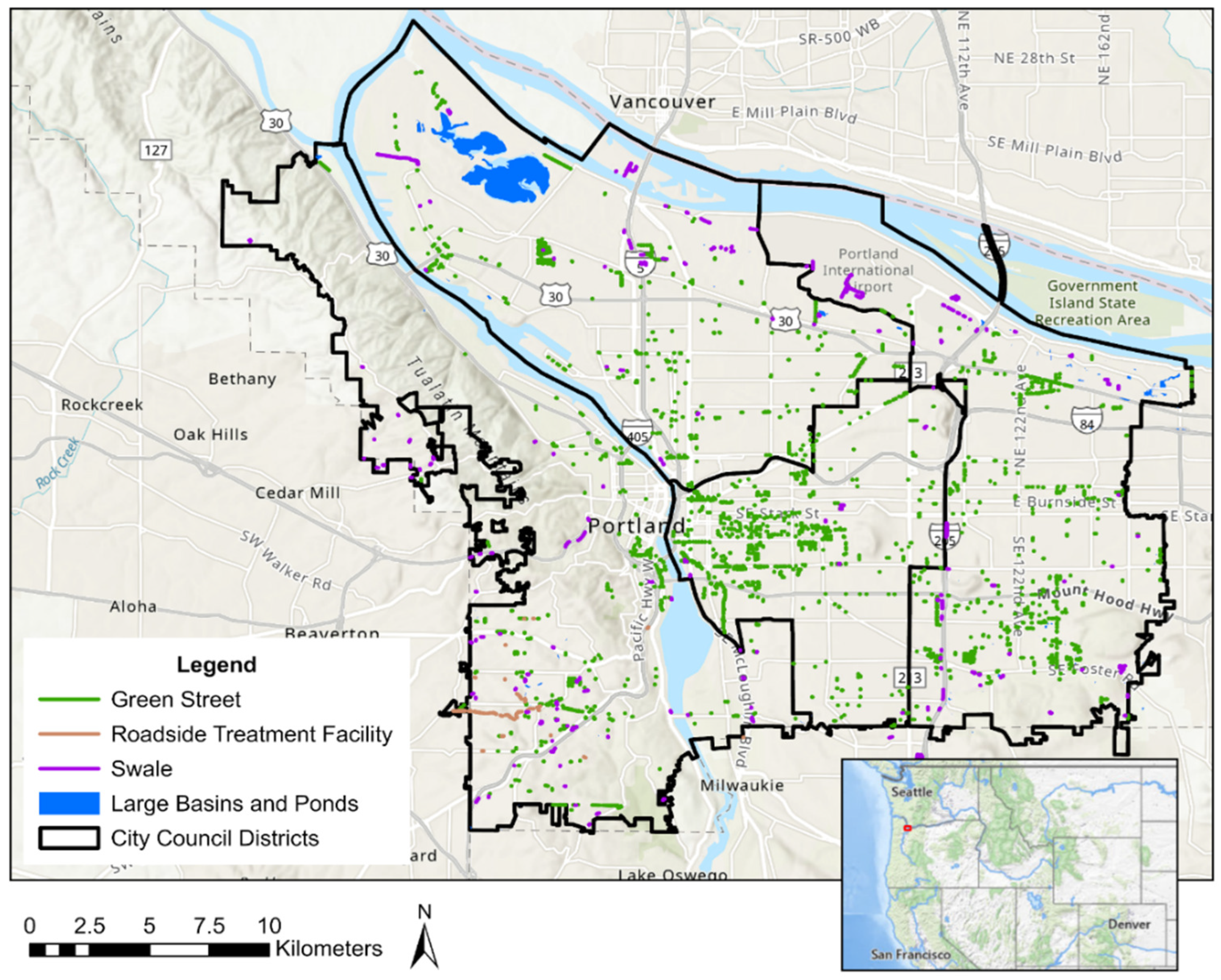
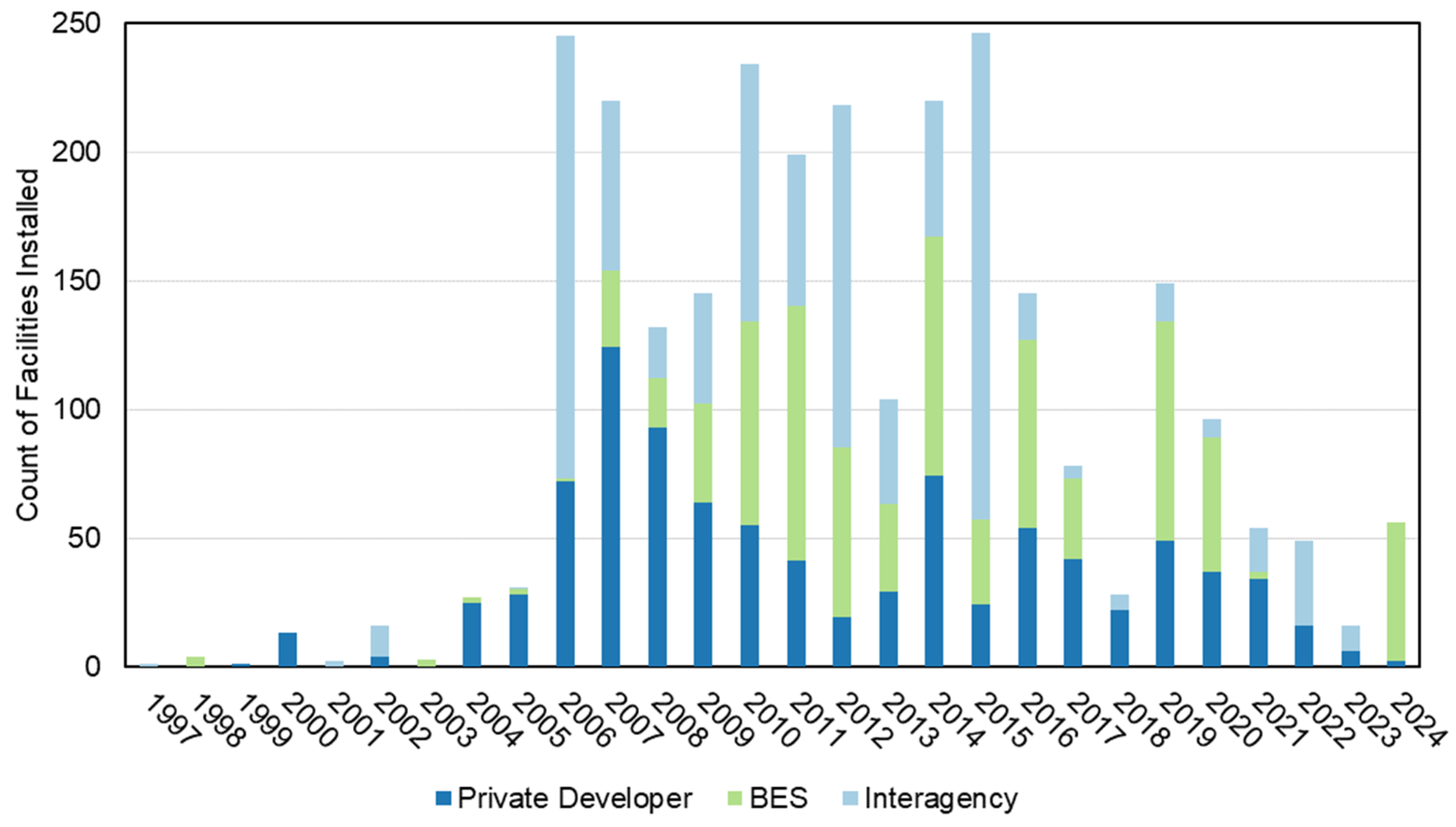
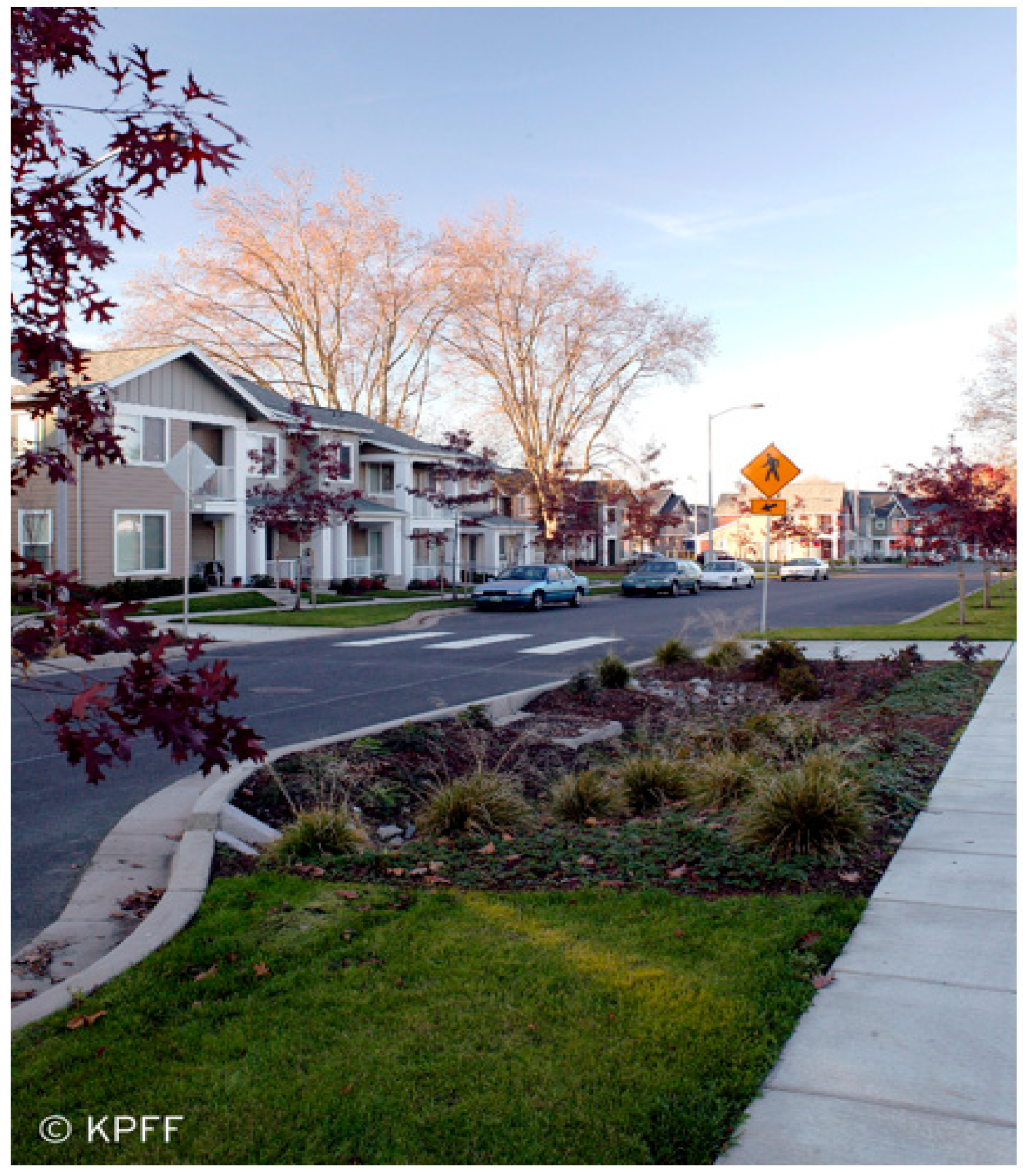

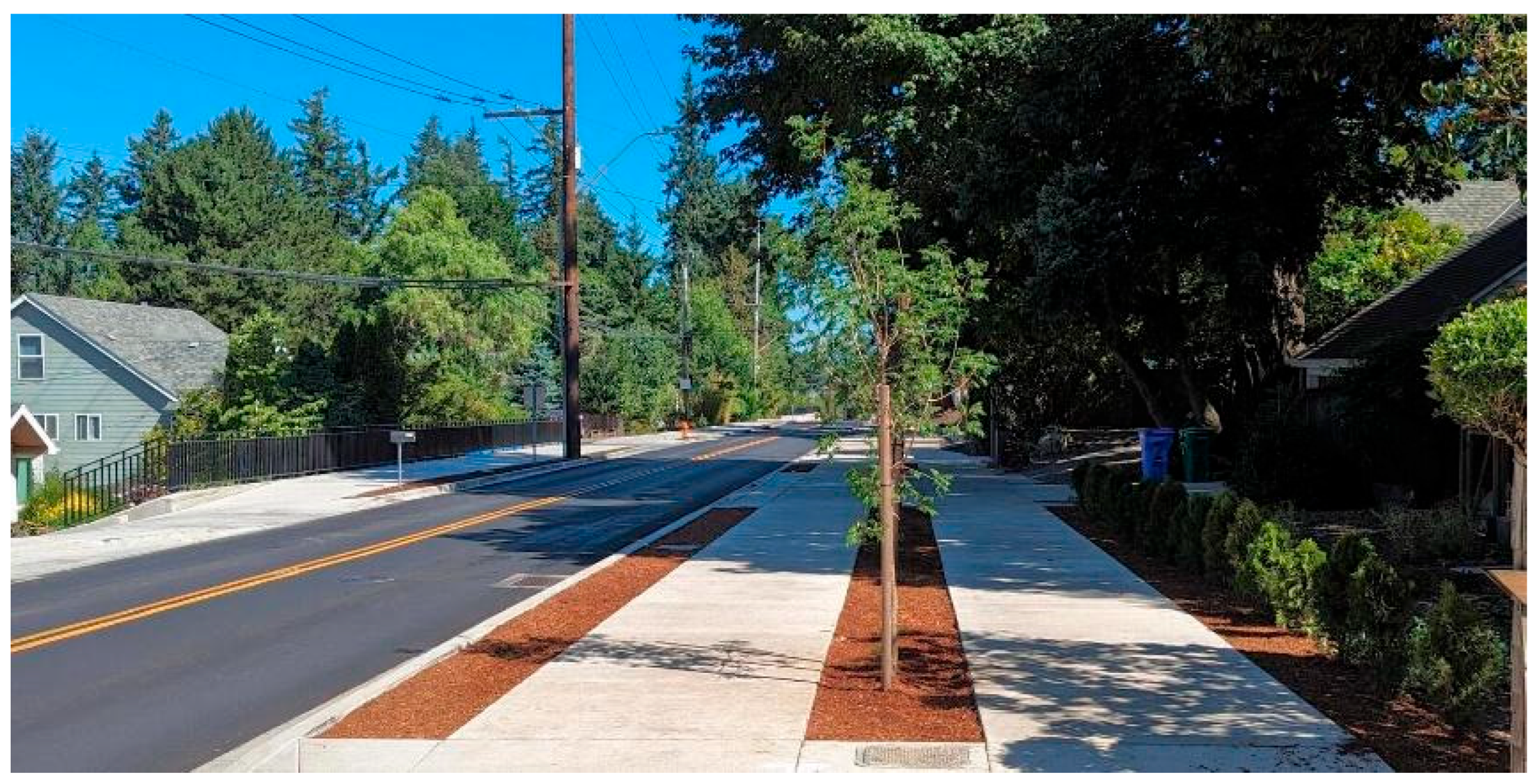
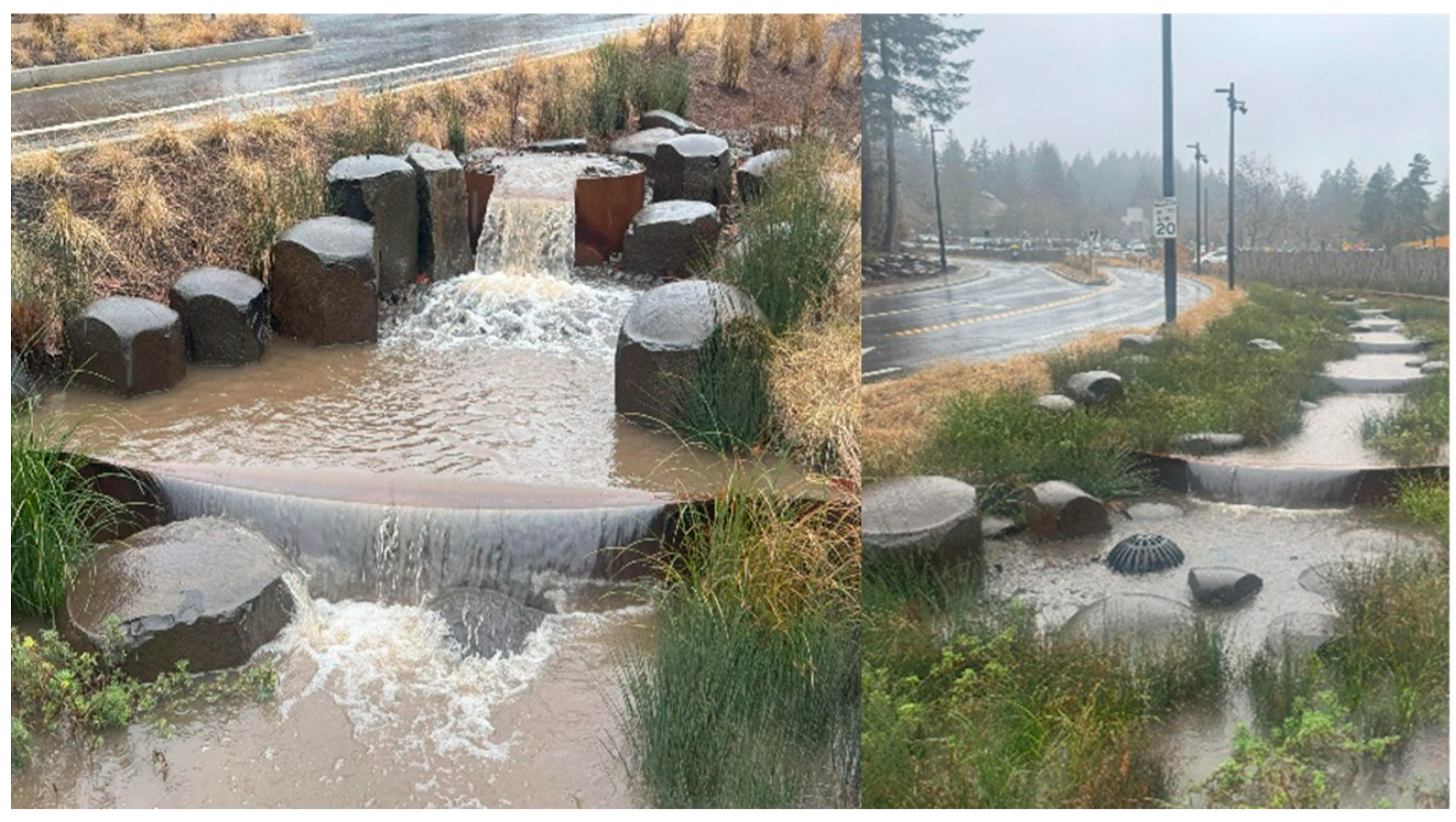

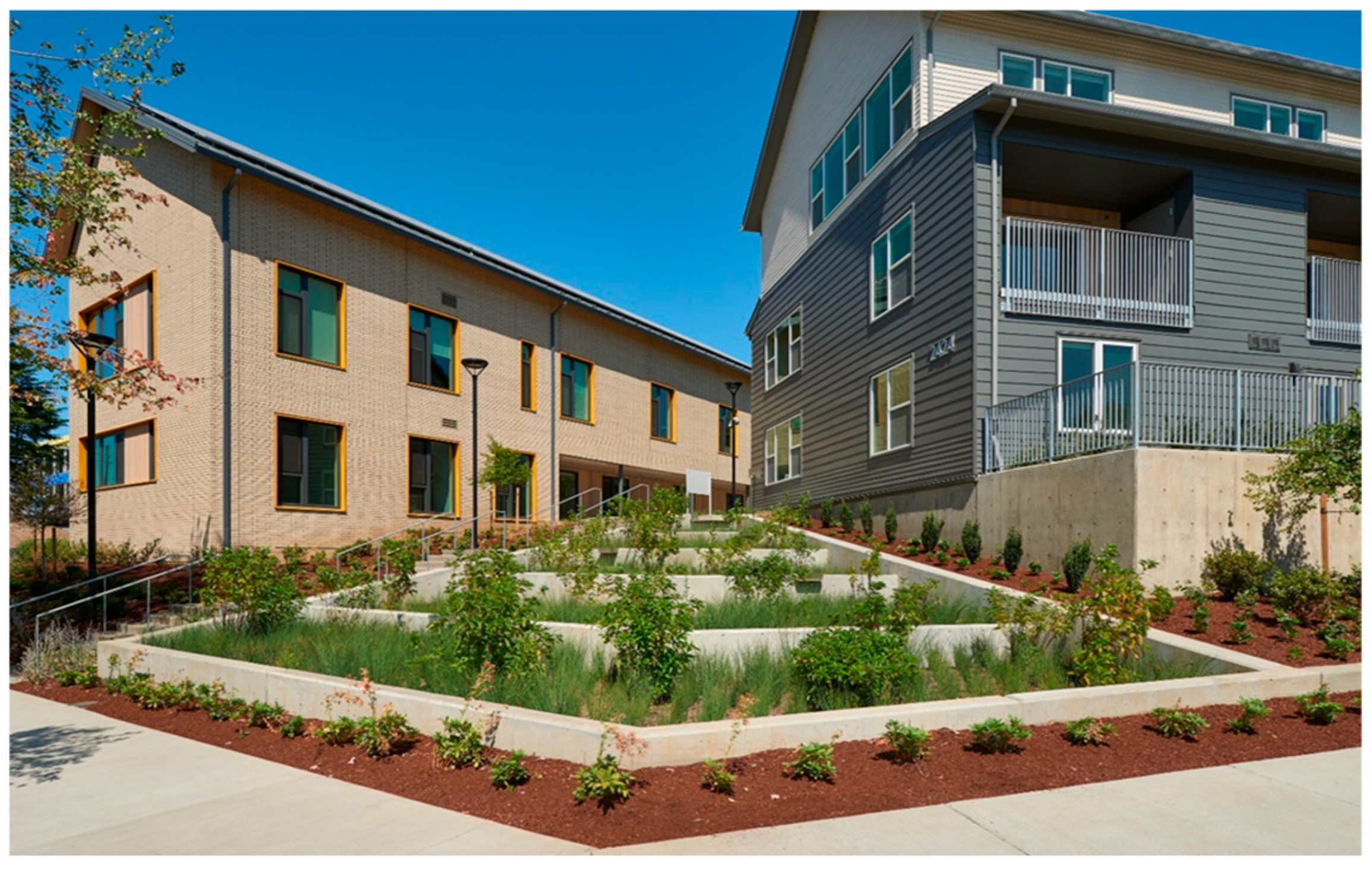
| Year | Event |
|---|---|
| 1845 | The City of Portland is incorporated |
| 1952 | Portland opens its first wastewater treatment plant |
| 1977 | Portland creates a stormwater utility and charges a stormwater utility fee |
| 1991 | Portland enters consent decree with Oregon DEQ to reduce CSOs by 2011 |
| 1993 | Early vegetated stormwater facilities are constructed |
| 1995 | Oregon DEQ issues Portland’s NPDES MS4 discharge permit |
| 1996 | Downspout disconnection program launches |
| 1998 | Columbia River Steelhead Salmon listed as an endangered species |
| 1999 | Willamette River Chinook and Steelhead Salmon listed as endangered species |
| 1999 | The first Portland Stormwater Management Manual (SWMM) is published |
| 2000 | The Portland Harbor listed as a Superfund site |
| 2000 | Construction of the Columbia Slough “Big Pipe,” a 3.5-mile (6–12 ft diameter) tunnel to reduce CSOs, is completed |
| 2001 | The Green Building Program, which promotes installation of ecoroofs, is adopted |
| 2002 | The Green Streets pilot program launches |
| 2005 | Oregon DEQ issues Portland’s WPCF UIC permit |
| 2006 | Construction of the West Side “Big Pipe,” a 3.5-mile (14 ft diameter) tunnel to reduce CSOs, is completed |
| 2006 | The Clean River Rewards Program, which offers incentives for GSI installation, launches |
| 2008 | The Green Streets Policy established the Percent for Green grant program, which provides grants for GSI installation |
| 2009 | The Treebate Program, which offers a credit for planting trees, launches |
| 2011 | Construction of the East Side “Big Pipe,” a 6-mile (22 ft diameter) tunnel to reduce CSOs, is completed |
| 2018 | The Clean Energy Fund is established in Portland, which provides funding for green stormwater infrastructure projects |
| 2020 | The Central City ecoroof zoning requirement is established |
Disclaimer/Publisher’s Note: The statements, opinions and data contained in all publications are solely those of the individual author(s) and contributor(s) and not of MDPI and/or the editor(s). MDPI and/or the editor(s) disclaim responsibility for any injury to people or property resulting from any ideas, methods, instructions or products referred to in the content. |
© 2025 by the authors. Licensee MDPI, Basel, Switzerland. This article is an open access article distributed under the terms and conditions of the Creative Commons Attribution (CC BY) license (https://creativecommons.org/licenses/by/4.0/).
Share and Cite
Koucka, M.; Poor, C.; Wolfand, J.; Chang, H.; Shandas, V.; Aiona, A.; Stevens, H.; Kurtz, T.; Hedin, S.; Fancher, S.; et al. The First Thirty Years of Green Stormwater Infrastructure in Portland, Oregon. Sustainability 2025, 17, 7159. https://doi.org/10.3390/su17157159
Koucka M, Poor C, Wolfand J, Chang H, Shandas V, Aiona A, Stevens H, Kurtz T, Hedin S, Fancher S, et al. The First Thirty Years of Green Stormwater Infrastructure in Portland, Oregon. Sustainability. 2025; 17(15):7159. https://doi.org/10.3390/su17157159
Chicago/Turabian StyleKoucka, Michaela, Cara Poor, Jordyn Wolfand, Heejun Chang, Vivek Shandas, Adrienne Aiona, Henry Stevens, Tim Kurtz, Svetlana Hedin, Steve Fancher, and et al. 2025. "The First Thirty Years of Green Stormwater Infrastructure in Portland, Oregon" Sustainability 17, no. 15: 7159. https://doi.org/10.3390/su17157159
APA StyleKoucka, M., Poor, C., Wolfand, J., Chang, H., Shandas, V., Aiona, A., Stevens, H., Kurtz, T., Hedin, S., Fancher, S., Lighthipe, J., & Zucker, A. (2025). The First Thirty Years of Green Stormwater Infrastructure in Portland, Oregon. Sustainability, 17(15), 7159. https://doi.org/10.3390/su17157159









